
Heroes for Wargames is a book about metal fantasy miniatures published by Paper Tiger Books in 1986.

Heroes for Wargames is a book about metal fantasy miniatures published by Paper Tiger Books in 1986.
Heroes for Wargames, subtitled "Painting & Collecting Miniature Figures for Role Playing Games", is a 128-page large-format paperback about painting and collecting miniature fantasy figures, featuring many illustrations of painted and unpainted Citadel Miniatures. [1] The book was written by Stewart Parkinson, with contributions by noted artists Kevin Adams and John Blanche. [2] Contents include:
In the May 1987 edition of White Dwarf (Issue #89), Mike Brunton stated that "This may not be the ultimate book on figure painting, but it'll do until the ultimate book turns up. Heroes For Wargames is probably ideal as a way of interesting someone in figures." [3]
In the June 1987 edition of Dragon (Issue #122), John Bunnell thought this book suffered from a number of limitations. He found the early chapters seemed to be written for someone new to the hobby, but later chapters seemed to imply the reader was an enthusiast. Bunnell, an American, found "a distinctly English sense of punctuation that sounds awkward to American ears." Bunnell also criticized the book's lack of organization, noting that illustrations were often several pages away from the accompanying text. Despites its flaws, he concluded that, "This should not imply that Heroes for Wargames isn’t useful on its own terms. Readers new to the world of miniatures may learn more than they want or need to know, and experienced artists may find some of Parkinson’s comments painfully obvious. But, while the book may be most valuable to gamers who want to refine self-taught painting skills, nearly any figure fancier should find something of interest within its pages." [2]

Games Workshop Group is a British manufacturer of miniature wargames, based in Nottingham, England. Its best-known products are Warhammer Age of Sigmar and Warhammer 40,000.

Miniature wargaming is a form of wargaming in which military units are represented by miniature physical models on a model battlefield. The use of physical models to represent military units is in contrast to other tabletop wargames that use abstract pieces such as counters or blocks, or computer wargames which use virtual models. The primary benefit of using models is aesthetics, though in certain wargames the size and shape of the models can have practical consequences on how the match plays out.

Warhammer is a tabletop miniature wargame with a medieval fantasy theme. The game was created by Bryan Ansell, Richard Halliwell, and Rick Priestley; it was published by the Games Workshop company.

In miniature wargaming, players enact simulated battles using scale models called miniature models, which can be anywhere from 2 mm to 54 mm in height, to represent warriors, vehicles, artillery, buildings, and terrain. These models are colloquially referred to as miniatures or minis.
Miniatures games are a form of tabletop game which prominently features the use of miniature models or figures.
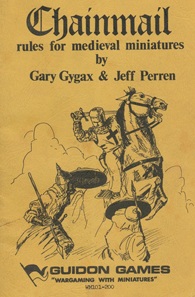
Chainmail is a medieval miniature wargame created by Gary Gygax and Jeff Perren. Gygax developed the core medieval system of the game by expanding on rules authored by his fellow Lake Geneva Tactical Studies Association (LGTSA) member Perren, a hobby-shop owner with whom he had become friendly. Guidon Games released the first edition of Chainmail in 1971.
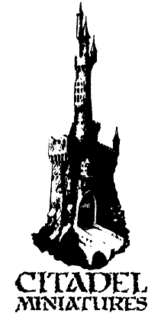
Citadel Miniatures Limited is a company which produces metal, resin and plastic miniature figures for tabletop wargames such as Warhammer Fantasy Battle and Warhammer 40,000.
Collectible miniatures games (CMGs) are a form of miniatures game that is also similar to collectible card games (CCGs) — the primary difference being that while CCGs are card-based games, CMGs feature miniature figures.
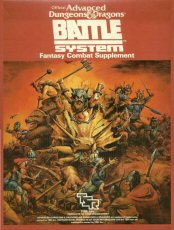
Battlesystem is a tabletop miniature wargame designed as a supplement for use with the Dungeons & Dragons role-playing game. The original Battlesystem was printed as a boxed set in 1985 for use with the first edition AD&D rules. For the second edition of AD&D, a new version of Battesystem was printed as a softcover book in 1989.
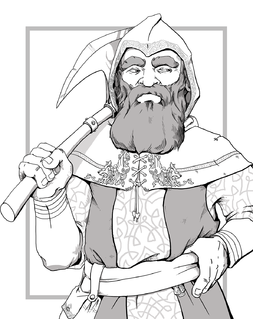
A dwarf, in the Dungeons & Dragons (D&D) fantasy roleplaying game, is a humanoid race, one of the primary races available for player characters. The idea for the D&D dwarf comes from the dwarves of European mythologies and J. R. R. Tolkien's novel The Lord of the Rings (1954-1955), and has been used in D&D and its predecessor Chainmail since the early 1970s. Variations from the standard dwarf archetype of a short and stout demihuman are commonly called subraces, of which there are more than a dozen across many different rule sets and campaign settings.
Grenadier Models Inc. of Springfield, Pennsylvania produced lead miniature figures for wargames and role-playing games with fantasy, science fiction and heroic themes between 1975 and 1996. Grenadier Models Inc. is best known for their figures for TSR, Inc.'s Advanced Dungeons & Dragons game, collectible Dragon-of-the-Month and Giants Club figures, and their marketing of paint and miniature sets through traditional retail outlets.
Bryan Ansell is a British role-playing and war game designer. In 1985, he became managing director of Games Workshop, and bought Games Workshop from Steve Jackson and Ian Livingstone.
The DL series is a series of adventures and some supplementary material for the Advanced Dungeons & Dragons role playing game. These modules along with the Dragonlance Chronicles trilogy of novels, which follow one possible adventure series through the modules, were the first published items that established the Dragonlance fictional universe. The original DL series was released from 1984 to 1986, with the final two modules added to it in 1988. In the 1990s these roleplaying adventures from the original series were collected and revised for 2nd Edition AD&D as the three DLC Dragonlance Classics modules. There were also versions of the module series released in 1999, 2000 and 2006.
Ian Marsh is a British writer, magazine editor, and entrepreneur.

The original Dungeons & Dragons boxed set by Gary Gygax and Dave Arneson was published by TSR, Inc. in 1974. It included the original edition of the Dungeons & Dragons fantasy role-playing game. Its product designation was TSR 2002.
John Blanche is a British fantasy and science fiction illustrator and modeler who worked on Games Workshop's White Dwarf magazine, Warhammer Fantasy Battle, Warhammer Fantasy Roleplay and Warhammer 40,000 games and was the art director for the company and illustrated various game books and Fighting Fantasy publications.
Formed in 1975, Ral Partha Enterprises, Inc. of Cincinnati, Ohio, United States, is now known as Ral Partha Legacy Ltd. and produces miniature figures in 25 mm, 30 mm, 15 mm, and 54 mm scale. The company's products are made by spin-casting metal alloys which depict soldiers, adventurers and creatures that have been inspired by history and fiction. Their miniatures are sold at gaming conventions, in hobby shops, and by internet and mail order for use in role playing games, wargaming, dioramas, competitive painting, and collecting.

Asgard Miniatures was a company that produced metal miniature figures beginning in the 1970s.
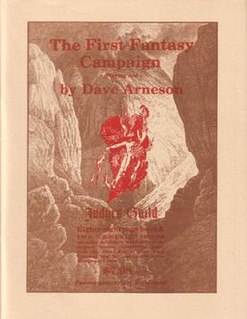
The First Fantasy Campaign is a supplement for fantasy role-playing games written by Dave Arneson and published by Judges Guild in 1977.

Dixon Miniatures is a British company that produces miniature figures for wargaming and role-playing games.